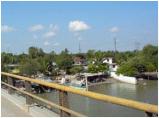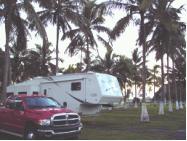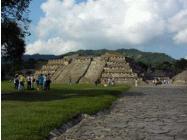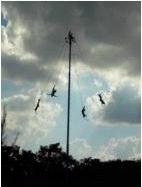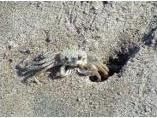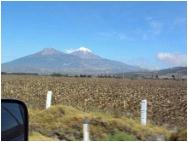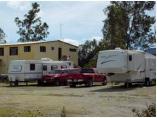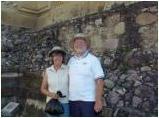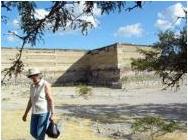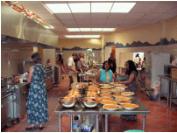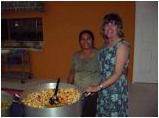A few months ago, I got an email from Paul and Juanita Alton, relating their very interesting experiences RVing from their home in Canada to a mission in Mexico. So, here you have a first! This is the first time I've included travel experiences of someone other than me! After reading Paul's vivid and detailed monologue of their maiden RV voyage, I emailed him back and told him that I'd be really excited to be able to send this along to those who read my Travel Log. Here's the story ----
The first section "Canada to Mexico" obviously relates their trip down, as will be apparent as you start to read. The second "Into Mexico" takes you to Oaxaca, Mexico. Later chapters are planned to relate some of their experiences in Mexico, plus details on the trip back.
They're now in Big Sandy, Texas, doing some more mission work, so we'll add updates to this adventure as they get them written.
We stayed at my brother-in-law and sister’s (Joe and Judi Tait). We had an interesting time backing the trailer into their driveway with a car parked across the cul de sac, but managed and were able to get back out of the subdivision when we left for the ferry on Thursday with Judi on the blind side of the intersection making sure nothing was coming so we had room to turn. Praise God for sisters and walkie-talkies. In Powell River we had good visits with several friends and family, but we’ll have to come back and spend a few weeks to see everyone we want to. Next time we will probably fly into Comox and do a walk-on onto the ferry from there to Powell River. Ferry fares are high enough to pay the flight from Edmonton. But this trip I wanted my Mom to see our trailer and how we were going to live. It helped.
In Edmonton, we went to a strip mall on the south side so that Juanita could spend her birthday gift certificate for some of Tilley’s clothing. This is an innocent sounding sentence that carries none of the logistical prelude (maps, reviewing Google Earth satellite images, discussing possible parking spots for something that is 53 feet overall length, etc.) or stress of execution. That said we survived, and were soon back on the Whitemud freeway working our way back across the river to the Yellowhead and Mackenzie highways and on to Whitecourt, arriving at Jim and Bonnie Fisher’s at dusk. I walked into the property and decided we would be able to turn the rig around if we went in there and proceeded. Turning around was relatively uneventful other than this horrible crunching noise at one point. I later decided that it is the noise of the ¾” steel square stock handle coming in contact with the hitch when the truck and trailer are close to 90 degrees to each other. I am pondering cutting an inch off the handle – whether that will help or just mean I tend to turn tighter and scrunch the truck cab with the trailer – choices, choices. We had a delightful dinner and visit with Jim and Bonnie and boys and toured their kennel facility. Nice set-up! Then it was up early to head off in the darkness down the Peerless road to rejoin the Yellowhead highway.
We pushed on to Kamloops and decided to carry on to the Coquihala that day (October 16th) while it was still almost daylight and the temperatures were above freezing. The truck didn’t set any records going up the hills, but by keeping a careful eye on the temperature or the turbocharger we made it to the tops of the hills. Careful use of the transmission and finally figuring out how to adjust the trailer brake controller meant we made it alive to the bottoms of the hills. By the time we got to the toll booth it was dark, as we knew it would be, but we were more afraid of facing ice in the morning than dark now so we proceeded. We survived. Not a catchy phrase, but one which is better than the alternative. We carried on downward eventually hitting fog and rain near Hope, but carrying on until we were beyond Hope (ha ha) to Chilliwack. The Safeway manager graciously gave us permission to stay in the WalMart parking lot next door and we parked the rig near some others and slept the troubled sleep of the traumatized. The next day we headed into Surrey to park the rig while we went downtown to do some paperwork. The radio mentioned that the road between Hope and Chilliwack was closed since a cliff of mud had collapsed on it during the night. Good thing we pressed on. We followed directions to a campsite in Surrey. We got a few blocks into the route and turned a corner to come face to face with a torn up road and a “Road Closed” barrier. The truck and trailer were able to make a u-turn with only a little crunching noise and the right front tire with millimeters to spare between the edge of the side walk and the six foot drop-off in the blackberry bushes. The quote “if you don’t like my driving, stay off the sidewalk!” comes to mind. We worked our way to Guilford and followed the direction to getting to the park from there. I’m sure glad I took that truck driving course – can’t imagine doing anything like that starting from scratch. Once at the campsite we bought temporary parking cheaply on the promise we would be back to stay for two nights on the following weekend. We left the rig hooked up and caught a cab to the nearest Sky Train station and headed to downtown Vancouver. With a call to the pension people we were able to move our appointment up to eleven. It had originally been at four to allow time to come from Kamloops. After our appointment we had lunch at a cooking school – good food, lots of it, great prices – and then bussed and sky trained our way back to Surrey, picked up the rig and headed for the Horseshoe Bay ferry terminal. The drive up the Sechelt peninsula was relatively uneventful – In Powell River I was able to re-attach the spare tire bracket broken getting onto the second ferry and the body shop fixed the corner of the truck bed which got scrunched by the underside of the trailer while pulling into a gas station (they had widened the road and the driveway into the station was shortened and now very steep and when you add the twist when you try to turn for the pumps you “live and learn”).
When we retire we have this illusion we are going to have time to do certain things and time to not do certain things. We tend to blame our employment for our time poverty. I have come to the realization that, like Pogo said, I have seen the enemy and he is us. If we aren’t doing the things we wanted to in retirement because we are busy, perhaps the busyness is and was (by implication) self-inflicted. One of the things I was looking forward to was never again driving in the dark. As I find myself driving in the dark I realize it is me setting unrealistic deadlines and pushing to meet them that means I end up driving in the dark.
Well that hour is up and it is about time to head for church so I’ll send off a one-liner e-mail and carry on writing later.
We left Powell River on Friday, October 21 catching the second ferry from Saltery Bay and arriving in Vancouver midday. We parked the trailer at the RV park in Surrey, did some temporary repairs to the door between the bedroom and living room / kitchen area and went off to do some shopping before going over to my other brother-in-law and sister’s (Syd & Dan Adamson) for dinner and a visit. After looking at the price of some of the permanent solutions for a door latch at Lee Valley Tools I made other plans for the door. On Saturday I drilled out the original snap fastener on the retaining strap and screwed one end to the wall (still working about 8k km. later). We met Guenter and Anita Salchert for dim sum at Granville and 41st and had a great visit. After that we went back to the trailer and decided there was nothing keeping us in the lower mainland and we headed for the border. Waited while the only ag person on duty had time to run out the slides and open our fridge looking for contraband apples and then headed south to Tacoma and the Camping World parking lot. There were several other rigs overnighting in addition to ours. After walking over to McDonald’s for a leisurely breakfast, Camping World was open and we picked up a number of things that we had been waiting to buy, but didn’t want to pay UPS and customs charges for. One was a surge arrestor that would allow us to use the Air Conditioner without putting it at risk. The surge arrestor built in to the inverter did not like the inrush current on the AC so we had never been able to use it, and although I had bought a load center that could allow us to connect the AC electrically ahead of the other loads in the trailer the AC would still be at risk of sub standard electrical services that one can come across. After our shopping spree we headed south.
As we got close to Portland we called Larry and Loretta Benson, our former pastors from Powell River and wended our way through some subdivision streets to their home. After a visit of an hour or so we headed south again. They are old RV hands and had been to see us in Saskatchewan with their motor home a couple of years ago. One of the stories they shared on today’s visit was of her sister and husband’s recent purchase of a motor home. They left the dealership and made the first stop on the way home at Camping World. Although this is our maiden voyage we had lived in the RV for six months before stopping at Camping World. There were a lot of “essential” things we could walk past with hardly a twitch. Couldn’t have done that the first week. All those gadgets really would have seemed essential.
To put it in perspective the Coquihala is 6% & 8% grades.
The transmission was already at 190 degrees (alarms at 200). We turned around in a gravel pit around the next bend and skulked back to Lucerne Valley. I looked into some RV parks where we could drop the trailer and take just the truck up to see Juanita’s sister, niece and nephew (Shirley, April and Jeff Darling, respectively). Then Jeff and I talked by cell phone and he gave us directions to an alternate route that went much higher overall, but was less steep. Six hours later we were there, after braving desert cross-winds between Yucca Valley and Palm Springs, getting temporarily wedged between the pumps in a gas station (no damage), rush hour LA traffic, and taking the road up the mountain from Redland in darkness and fog.
We had a good visit with Shirley and April. Shirley has just moved there and her modular home was in place, but not quite finished.
Jeff is director at Pine Summit Christian Camp and Conference Center. We stayed in one of their RV parking spots and I did some maintenance work (but not much – they are not used to volunteers and tend to see their backlog of maintenance work in terms of what their paid staff will be able to tackle within a reasonable horizon. If you look closely there is no shortage of stuff that could be done. I think my passing through may have started the maintenance supervisor thinking about packaging some related groups of maintenance tasks into project type bundles and then soliciting volunteer groups to tackle them.) The maintenance guys were a great team of skilled tradesmen with the attitude of doing their work as a ministry as well as the usual pride of craft that good tradesmen have. The work I did included finishing the fireplace mantle in one of their new buildings.
A few times there was a shortage of things that they couldn’t handle with the staff they had so I did get a few things done on the trailer such as install the load center and the surge arrestor and even washed it for the very first time (note to whom it concerns – when you are washing the trailer with a deck brush don’t bang the light near the door with the wooden head, but if you do then some phase tape will keep it on the trailer until you pick up a replacement lens at Beaudry’s RV in Tucson).
The camp is owned by a conservative Baptist conference and on the weekend they had several hundred men there for a retreat. I sat in on several of the sessions (a couple of great speakers – strong in the word with really challenging messages) and went on one of the boats they rented for trout fishing. Our boat caught a couple of small trout, the other boat caught none, but it was nice to be out on the water for a few hours. A tour boat passed by. It was a pirate ship that had been in the movie, “Time Bandits”.
The Sunday sessions wrapped up in time for Juanita and I to go to church with Shirley and April and then Juanita and I started a drive around the lake. We stopped at an information center and learned a little about Big Bear Lake and area. Being that close to Hollywood and with the pine trees it has been the shooting location for hundreds of movies in the thirties, forties and fifties. Many of the movies were westerns or supposedly located in Canada, but even the 1954 version of “Heidi” was filmed there. I picked up a brochure about a circle tour of some of the gold rush mines in the area so we turned off the lake road a couple of miles from the information center and headed up a canyon. I don’t think Juanita was too impressed, especially when we were on the one lane downhill section across a cliff face with the road surface composed of ball-bearing like pebbles, but it gave some perspective of what the early gold miners went through in discovering and processing gold. The brochure mentioned that one mine brought in a four ton boiler by horse and wagon. “The trip took 27 days from Los Angeles to Holcomb Valley.” Nowadays it would be a morning delivery and the trucker would be back in L.A. for the evening.
In addition to the challenging messages from the conference speaker, one other event gave me pause for thought. Dave, the relief supervisor on the maintenance crew was a committed Christian and a bit of a jokester. On Friday a part-time maintenance employee was at the morning devotional/ crew meeting for the first time since I had been at the camp. He introduced himself and said he was the young guy that everybody liked to pick on and tease. I said that I had been that person once in a shop, but eventually it goes away as you move closer to the front of the line in the march to the grave. Dave laughed and said he really liked that. Later, as we were taking a break from stacking steel framed picnic tables we were standing there huffing and puffing and Dave and I compared facts and determined that he was a “youngster” seven months younger than me. He dropped dead of a heart attack on the Saturday. The crew meeting was pretty somber on Monday, but there was still the realization that Dave had the assurance of his salvation and that this life was just a phase of the eternal one.
Pine Summit had collected a bunch of clothes for Hurricane Katrina victims, but all relief agencies wanted only cash so they asked us if we would take these clothes to Mexico. They were all washed and sorted by size into garbage bags – a pickup load of garbage bags which were dumped next to our trailer. Juanita and I stuffed and stuffed and only had a few bags left over to stay at Pine Summit.
On Thursday, November 3rd we headed down the mountain. The road was better in daylight without fog and at a time of the day when there were fewer crazies zooming past. Once down at the bottom and onto the freeway we headed East on I10 until turning South at Indio. We took a brief detour to Mecca to buy some lunch at a hole in the wall (literally – it is a window in the wall between the inner and outer doors of a supermarket) restaurant we had discovered on a previous trip (pilgrimage?) to Mecca. Then we carried on southward to El Centro and eastward to Yuma to stay at an RV park in Wellton, Arizona. I had a feeling that this might be the town where Dave Dowling, a workmate from Powell River days, might winter, but the most likely of the RV parks didn’t know of him. His house in Powell River looked pretty vacant when we dropped by so I had thought he might already have moved south for the winter, but maybe he hadn’t or more likely it is a small world, but a big desert and I was one town or one RV park out. Oh well, we tried, but not too hard and it was a pleasant drive around and I could see from how some of the parks were set-up why people stay there for the winter.
The next day we got under way fairly early. Traffic was light so I stopped at a rest area and Juanita drove the rig to the next rest area - pretty uneventful. I didn’t try to give her my truck driving school experience of yelling abuse at her, but by the same token she didn’t do any of the boneheaded or incompetent things that I subjected my truck driving instructor to early in that traumatic week of driving a tanker through the streets of Yorkton. When I suddenly improved part way through the week and he wanted to know what happened to the “other guy” I was able to explain to him that it was the same guy, but my wife and I had prayed a lot about the matter the night before and she was back at the motel praying for me so that was the only possible explanation. But I digress.
We got to Tucson, dropped the trailer at the church where we were married (now called New Life Center, then called Del Norte Baptist Church) and took just the truck to scope out the dead end street where Gary and Diana Lynch live. It looked like we could fit and it did. We arrived in time for Gary to contact the ride-along he had for the evening shift that evening and move him to another date so I got to ride with Gary one more time in a Tucson City Police cruiser. It was as fascinating as usual. I have to say the county jail has improved since the last time I was in it about fifteen years ago. At least Gary didn’t arrange to have the jailers stop me from leaving with him like he did one ride-along. Of course I didn’t provoke him with a stream of donut/police officer jokes either. There might be a connection.
Saturday morning, Juanita and I met with Janet McIntire for breakfast, then Gary took me out and bought us one of “The Club” theft deterrent devices for our truck. When he said we should have one I was convinced and when we went shopping I still thought it was something I was going to pay for. That and some other things that Gary and others have done for us is a bit of an adjustment. In addition to an independent spirit that likes to take of one’s own needs it is still something of a different perspective. I still look at us as just another retired couple doing something they think they are supposed to do. That somebody would give something to us as unto the Lord is humbling and in a way bewildering at an emotional level.
On Sunday we went to church at New Life with Gary and Diana. There were just a few people there from when Juanita was secretary there thirty years ago. Hardly surprising.
After lunch we headed to Benson, Arizona and spent the next two nights parked at Steve and Sandy Ball’s. They have set-up sewer and water connections. On Monday, Steve had some errands in Tucson so I went along with him and managed to pick-up an item at Camping World and a lens at Beaudry’s as well as some wheel seals for the trailer from a place that was closed on Saturday. It was interesting to tag along on some of his errands to a nursery looking at different trees for the church that is being built in Benson and have the nursery man explain how big they will get and how they will fare in the higher elevation at Benson. Also we went and priced rocks for the same. I can’t get my head around the going price of $US300 for a nondescript (maybe even ugly) three foot diameter rock.
On Tuesday we got off to another early start and a late finish at Ft. Stockton, Texas. Picked up a pizza on the way to the RV park and rented 24 hours of wi-fi connection to send out a few updates and crashed (bad term – I mean slept). The next day it was another hard day’s drive to McAllen, Texas. We missed the turn to the Valley Baptist Conference Center and recovered from that and got to the gate we had been given directions to. As usual at times of most stress, it was dark. The traffic piled up while we tried to figure out the turn into the center and then started honking so we carried on and turned on the first street that looked like it might be a cross street and not a dead end. I pulled over and after a couple of tries got the phone number of the center and then the cell phone number that was recorded in burst mode on the voice mail message. We talked to a real live person and she gave us direction to another parking lot which we eventually found. She called somebody who said he’d be there in twenty minutes. After an hour and a half she called him again and he came and said he would meet us at the gate. We got there before he did and so it was once more around the block. It is always easier the second time. While we were waiting for him the person I had contacted by cell phone said all sorts of terrifying things about the risks of crossing the border and driving in Mexico and so on. She did arrange for their Mexican work group coordinator to meet us at the border at Brownsville the next morning at eight and said we should start by seven. After we settled in we managed to talk to a missionary couple in the next trailer. They had spent several years in Oaxaca and came back to the States because he had had a stroke. He was a little skeptical of all the alarmist things we had been told and gave some good practical advice on traveling in Mexico and in crossing the border and even to traveling to Brownsville from McAllen (allow 1 ½ to 2 hours). We also found the clothes may be a problem, but we’d find out.
We had been told to pull into the “declaration” lane, but as we tried it was apparent we would get wedged so a customs officer spotted for us to back up into a curb lane (the motor homes took up all the space where we would normally be parked). Our paper work was routine so it was done inside by 10:30 (line-ups you know), but the motor homes had other challenges and they were ahead of us outside. You cannot bring more than one vehicle into Mexico at a time (there are rumours that this may have changed in the last few months, but don’t count on it). This means the motor home has to be in one name and the toad in another and both owners have to accompany their vehicle across. This meant going through some change of ownership procedures for the French Canadian couples. A few faxes to Quebec and back were involved.
By the time the officials had gone through the motor homes and dealt with the (at least one) obnoxious Quebecois, they only gave us a cursory glance and we were on the road by 12:30. We only missed one turn in getting out of Matamoros (the Mexican counterpart to Brownsville) and passed the motor homes coming back from the same wrong turn so it was easy to do, but it wasn’t long before we were on the highway to Ciudad Victoria (Victory City). The Quebecois had talked of going to Ciudad Victoria, but we never saw them again.
The road to Ciudad Victoria was a good road by Mexican standards. Let me explain. A typical good, modernized highway has two lanes – one each way and fairly wide shoulders almost wide enough for a vehicle. Everybody drives fast except those who can’t or don’t want to. Those slower vehicles drive partway on the shoulder and faster vehicles pass them expecting any oncoming vehicles to move out of the way. With this “system”, sometimes traffic is four lanes wide on a road that is almost four lanes wide. Vehicles that are driving really slowly often have their four-way flashers on. Sometimes they have them on if they are stopped or for some other unfathomable reason. When a vehicle wants you to pass the all-clear is signaled by turning on the left turn signal. Although occasionally that means the vehicle is turning left or has its four-ways on and has a burned out bulb on the right hand side. The correct or safe way to make a left turn is to pull all the way over to the right and wait until there is no traffic coming from any direction and then turn left. While waiting, hope you are not rear ended. Some roads have potholes you could lose a cow in. Many roads undulate and all roads have a least one tope (pronounced toe-pay – a type of speed bump across the highway) somewhere. Often these are marked with lines on them and signs on the roadside, but not always. Some topes can be a foot or more high. You don’t miss too many before you brake for illusions. It is best to follow somebody so you can be warned. You can also use them as a device to get past a semi. You pull over into the oncoming lane and cross the tope with your front wheels the same time as the semi crosses with its front wheels. By the time it gets its last set of wheels over you are around it. You hope. It might be the time somebody chooses to use the tope to pass you. You also have to watch for other vehicles whose drivers know the road so well as to know the sweet spots on particular topes. Sweet spots are where a vehicle can pass diagonally and receive less of a bump. Doing this puts them in some unexpected places relative to where you might otherwise expect them to be.
Pulling a thirty-four foot fifth wheel trailer on Mexican highways requires extreme concentration to avoid the hazards from the road, other vehicles, and contradictory or non-existent directional signs. You do not want to break any traffic laws and be stopped by the police. You do not want to speed. You do not want to commit suicide by going faster than road conditions allow. You do not want to be murdered by going slower than other drivers, almost all of whom are going much faster than the posted limit and will pass you anywhere to maintain that speed. Enough said. Well, almost enough. The really bad roads have no shoulders at all and people still drive the same way.
We got to Ciudad Victoria before dark and darted across oncoming rush hour traffic into the trailer park entrance. The entrance was deep enough to keep our backend out of traffic while Juanita pushed the gate wide enough open. After settling in we went for a walk a few blocks to a Sorianas (something like a Wal Mart with a bit more of a grocery emphasis) with a bit of a mall attached. We had supper and browsed the grocery section. My Spanish will improve quickly on this trip. Unlike in border and resort towns, hardly anybody speaks English. Juanita wasn’t in the mood for a movie, let alone in Spanish so we walked back to the park and called it a night.
The next morning we repaired some minor shaken loose type damage (I forget which – perhaps it was here the one valance got reattached for the second time and other for the first time) and I cleaned the interior of the truck cab for the first time in six months. We caught a bus to downtown (el centro) for five pesos each and walked around. We found a Scotiabank, but they wouldn’t take Canadian dollars or cash US dollar travelers’ cheques. They directed us to the BanaMex a few blocks away.
They had a really efficient system where you were handed a number when you came in and you sat on one of many comfortable chairs until you number came up along with the number of the teller window to go to. Teller wouldn’t take Canadian dollars or cash US dollar travelers’ cheques. Big kerfuffle behind the glass. Other person takes travelers’ cheque and disappears through a door behind the row of tellers. Eventually comes back and says to go to such and such a bank in such a such a direction. I get original teller to write down name and hope that I understood the directions. We find the bank stand in standard bank line up we are used to. I forgot to mention the BanaMex was air conditioned. This bank has sign saying it buys and sells British Pounds, Japanese Yen, US Dollars and Euros. We eventually get to a teller. Nope – won’t buy Canadian dollars. Will cash travelers’ cheque – still don’t know what they would do with all the information from me short of my blood type and a description of my grandmother’s tattoo, but they cashed the travelers’ cheque. Should have asked them to cash more, but I’m getting ahead of the story.
We had left Tucson with Lynch’s spare front door key. We needed to mail it back to them. Rather than mail it in an envelope to the address where it can be used, we decide to mail it in a card inside a card to Janet McIntire. We went looking to buy a greeting card. Papeleria is an extension of the Spanish word for paper and might be the equivalent of a stationery store. They do have paper and notebooks, but no cards. Shops selling regalos (gift) don’t have cards either. We found a small department store which had some cards. It also had a washroom. Like all public washrooms I have been in so far, it didn’t have toilet seats and it had a basket for the used toilet paper, but that’s the way it is here. We then went looking for post office. Due to November 11th holiday (don’t know what that has to do with Mexico – everybody is working) they let the postal employees go home at one pm. It is later than that. We walk around talking about what to eat for lunch. Juanita doesn’t want to walk past the same vendors the umpteenth time so we choose our route carefully. We settle on a food stand by the curb. Like the rest in the row it has about four stools on the sidewalk and the stand/cart is in the gutter. Its primary appeal to me (its differentiation in marketing speak) is that the main cook is wearing a hairnet. Sometimes you need to peg your assumptions on something, anything. Food tasted good, cost was low, never got sick. What more could one ask? They had a couple of packages of flour tortillas on the counter I asked about the price, but they were not for sale. I asked where the tortilleria was. It was seven blocks away. I said that was a long walk. The cook’s son sold me the package of tortillas at a price that was fine to us, but probably better to him. We were happy, he was happy. Hopefully somebody got more tortillas before the cook became unhappy.
We had walked through an indoor market while contemplating lunch. We went back there have dessert. Good pie. Grim coffee – heated up milk with a spoonful of Nescafe instant stirred into it. Then back on the bus to the trailer park.
Up early the next day – really early - before dawn. I had been reading about some dry lubricant for the slides. It made sense, but I didn’t have any. Did have some spray graphite lubricant. That should do the job until we get to a Camping World next year. Did you know that the propellant in graphite spray lubricant will set off the propane alarm and that nothing you think of will stop it until you pull the main fuse and it sounds really, really loud when it is still dark out and there are trailers parked either side of you, even if not right next to you because the RV season is not quite up to speed yet in early November.
We left right after that and followed the excellent directions provided by the trailer park owners to get out of the city and onto a reasonably good highway towards Tampico. We also followed her and others’ advice to go around the city and not into Tampico where the wires are too low and they will fine you.
The directions we had received from the mission were pretty good, but things sometimes change between when directions are written down and when they are used. The turn left under the bridge and cross the railway tracks had morphed into an exit to the right and take the overpass over the highway and the railway tracks and we whistled past the exit in the wrong lane to do anything about that, but the drive out into the country was nice and the narrow two lane road was not too narrow to prevent pulling off, down into a few giant potholes that engulfed a driveway and doing a u-turn. Back onto the divided highway and the next retorno that got us back the overpass and there we were, back on course.
We followed directions and carried on over some fairly bumpy roads to near Poza Rica, then we came to the intersection that we were told to turn at. We turned. The directions said to go up the hill and past the airport. We came to a branch in the road with a sign pointing one way to the Aeropuerto and another to the Autopista. The missionary’s wife in McAllen had advised not to worry so much about highway numbers as to follow signs that had the name of the next city/town you were trying to get to. We (I) turned to the branch that said it was going to the Autopista [kinda of an expressway, toll road but not always so grand as the term expressway suggests – there are Cuatos (toll-roads) and Libres (free highways). Cuotas usually are much better roads with less traffic].
We wandered around on this paved, country road along the sides of small mountains for almost an hour. It wasn’t bad. There was no other traffic. Nobody was forcing you to go fast on the switchbacks. At only one point did the road narrow to one lane – about thirty-five percent had sloughed away on the downhill side and fifteen percent on the uphill side (I don’t understand that unless the culvert was collapsing ). We scurried across that with no thought of stopping. We passed through villages where people stopped to stare like it was the first trailer they had ever seen. Eventually we came to a dump truck full of produce doing a three point turn in front of us. Good sign. We followed it. Houses started getting bigger and more estate like. Suddenly we were on an on ramp and playing high speed tag with semis again up and down through the mountains on a (relatively) broad well paved road. We came to a toll booth. We paid to get off. Now we were back playing tag with the same semis, plus all the ones that had taken the libre. Since this was a free road again it was windy and narrow, but fast unlike our sojourn through the villages. There were stands selling oranges and bananas, but no stopping is practical. They appear too fast and the pull off is too short to stop a fifth wheel in unless it is an emergency.
While we are on the subject of roadside stands let me mention a really strange thing we’ve noticed. You come to a little town and every business in the town seems to be selling the same thing. It may be fruit stands and they are all selling oranges, but that is somewhat understandable. A given spot will have the optimum climate for a particular crop and they all come to maturity at about the same time. That does not explain driving through a town with a number of large furniture stores all displaying the same furniture. Mitla, a town near Oaxaca, sells clothes – from fifty to a hundred clothes stores and stands all selling the same thing. Another town will only sell red pottery, another only black. I was in a town where there were rows of businesses manufacturing more or less identical cargo boxes that bolt on the back of trucks. Differentiation seems unknown. Commodification rules.
Eventually we start paralleling the coast, but inland a bit. The vegetation grows up to and over the roads. It reminds me of pictures of the Mekong Delta in a way. The road undulates. We speed onward. Eventually we are close to the water – we enter the Emerald Coast with hotels, restaurants, and trailer parks on the water side and crops, restaurants or gas stations on the inland side.
We find the park we have e-mailed. The owner is gone for the day so we agree to pay tomorrow and start looking for a spot that has hook-ups that work. We find one and park with an uneasy eye on the coconut palms and thoughts of what a wrongly placed dropping coconut could do to our solar panels. A guy who has been there for a while says they trimmed them recently and that has helped. Looking at the positioning of the trees I can’t envision a direct drop onto the panels so I move the worry to a back shelf of my anxiety closet.
We set up and quickly, before sunset, take a walk in the surf. We drive a few miles to a sort of corner store and Juanita goes in and buys some eggs which she cooks up and we eat them with the tortillas from Ciudad Victoria. Life is good we are alive. The air conditioner works. We sleep. We get up. We walk on the beach. We talk to some neighbours. More Quebecois. They tell us of an Internet café they go to inland about half an hour. We go there and both go on line and catch up on e-mail and political news from Canada.
The neighbours from the beach show up and occupy some of the other cubicles. We take a walk to a grocery store, buy some food, hit a bank machine (it doesn’t like our accounts so we just get a modest cash advance on a credit card. Sometimes modesty can be a pain, but more about that later) buy a couple of pears from an old lady and some ice bars from a store and walk back to the truck. There are some ruins, back up the libre the way we came and beyond. When we talked about it in the morning I was in no mood to drive, but driving the truck around on its own has been okay. I suggest we head to the ruins. The drive is fine. After pulling a trailer for so long without it the truck seems snappy. I am able to pull out and tromp it and pass something and get back in my own lane. The road doesn’t seem so bad. After a trip through a cobblestoned mountain town and over another ridge or two we are at Tajin, a Mayan ruin. There are voleadors who drop about a 150 feet with cords attached to their ankles and there are lots of pyramids. Most interesting.
We make it back to the trailer before dark and have another walk on the beach. This time we are accompanied by a pair of German shepherds that live at the RV park. We chase crabs together with them. They eat the crabs they catch.
Monday, November 14th marks the last day of a month on the road and the day of the last big push to Oaxaca. Up early. On the road early. Risk life, and race past some slower vehicles. Oh no! Bathroom break required. Pull over. Vehicles pass. Bathroom break complete. Oh well, the road is supposed to get wider as we get closer to Vera Cruz. It does. Four real lanes. Wow. Follow directions for bypass. Works well. Two lane road. Toll booth at beginning. People with flags to help you across railroad tracks. Don’t have to pay, but happy to toss a few pesos in cutoff pop bottle to know we are not going to be some level-crossing poor visibility statistic. Same drill at four way stop. Then onto cuato to Mexico City. Real freeway. Four lane divided highway with two lanes each way and limited access/egress. Dial in cruise control at 100 km/hr except watch for long upgrades which can sneak up you with high turbo temps.
[It’s past midnight – I’ll get back to this missive mañana. Good night.]
[Well, it’s Monday night November 28th and here I am keyboarding again. Just spent some time playing by adding a few pictures – I’ll try to wrap this up and send it off tonight or tomorrow. Apologies in advance it is long and basically a first draft, but just think back to the olden days of fifteen or more years ago when personal letters were all handwritten and in stream of consciousness format.]
The road was great until around Orizaba when it split into two lanes going one way and two lanes coming the other in order to climb this mountain for many miles, up into the pine trees. The road is not as steep as some we have seen, but it never seems to stop climbing and with two lanes we are not holding anybody up on the grades and switchbacks, but in the back of my mind is what the other two lanes going down the mountain will be like in three and a half months. Oh well, sufficient unto the day is the evil thereof. There is no point worrying about some distant tomorrow, today is about to get interesting. The next cobro (toll booth) we stopped at wanted 340 pesos toll. This generated some discussion with the toll booth operator, but there was no mistake. That is how much he wanted and also he seemed to be saying there were two more toll booths on the road to Oaxaca, but I was not sure if that is what he was saying. Sometimes the question you think you asked was really another one and sometimes the answer is wrong even if you communicated the right question and sometimes you don’t understand the answer when it is right. We paid the toll and moved on, but the discussion and angst increased in the truck cab. That toll was about four times the tolls we had been paying so far and there was some doubt about whether we would have enough pesos for tolls and whether we had enough fuel without stopping and spending our scarce pesos at a Pemex station. The only gas stations in the country are government run Pemex stations that are cash-only and that cash is pesos-only. We had lots of Canadian dollars (“Why pay two exchange fees by buying US dollars when we can just buy pesos directly with Canadian dollars?” had been our thinking, but like a lot of logical ideas it suffered in the execution). We had some US dollars, lots of traveler’s cheques and even more plastic. We had been pretty confident we would have enough pesos until the gargantuan toll, but that rattled our confidence to the core. I pulled over at the wide spot after the toll booth and asked in the store if they had an ATM. Nope. Buy American dollars? Nope. We drove on. We came to the exit for the autopista to Oaxaca. It had a different number than in our written directions from the mission. The driver (me) wanted to follow the name like the missionary in McAllen said. The navigator (guess who) said it was not the right number and not the right road. Much emotion. Split second decision. We carried on toward Mexico City. Much more emotion. Stopped at a Pemex plaza. Neither restaurant nor gas station had ATM or bought American dollars. Made a private deal with gas station attendant to sell him $US 65 for 500 pesos. Not exactly the going rate. Quick! Name another four letter word that you can make from rate by just changing one letter. That's what it felt like in a sense, but I relaxed and made the deal.
We drove on toward Mexico City. An exit for highway 190 to Oaxaca never materialized. Eventually another exit did. It was to a town called Acatzinga. I parked the rig at the Pemex station on the edge of town and asked one of the attendants where the Banamex was he told me about a ten minute walk that way.
I started walking. This town makes truck boxes. Sorry, no pictures. Shame really, they were very colourful. If I ever go back I promise to take one for you. After about five minutes of walking I came to a middle-aged, neatly dressed man in a checked shirt and straw hat (typical going-to-town attire for a labourer). When asked he tells me that the Banamex is about a ten minute walk. These people obviously walk a lot faster than I do. Either that or they don’t want to discourage anybody. He looks like he is waiting for a bus. I ask. He is. He suggests a taxi. I tell him I don’t have the money (who knows if the Banamex will give me money). I ask how much the bus costs. He holds up a ten peso piece. I visibly count my pocket change. I have a little more than ten pesos. The bus arrives. He pays the bus driver ten pesos for both of us. He won’t let me pay. The bus driver wants six pesos each. He won’t let me pay the two pesos, either. After about a ten minute ride the bus is near the market square and my benefactor indicates it is time to disembark. He gets off with me, walks me to the Banamex and the line-up to the bank machine and disappears upon my thanking him. I never see him again.
There are two bank machines in a little room with a glass door off the sidewalk. One is out of service to serve you better. At least that is my translation of the words on its screen. There is a woman and her daughter ahead of me. They go into the little room with the two bank machines. Things seem going well until there is some excitement and the woman sends her daughter out of the room and around the corner into the bank itself. On her way by I ask her if the machine is rompio (broken), but no, it is just out of money. An attendant comes running talks to the woman. He then disappears and soon she starts getting her money. It is my turn. The formerly working machine now also carries the display that it is out of service to serve me better, but I can hear the guy working away in behind the machine and I ask if it will be long and it won’t be and it wasn’t and I took out far more money than we needed on two different cards partly to see if I could and partly as a knee-jerk survival instinct. It turned out we would have made it without the extra cash, but who knew. I took a taxi back to the Pemex station.
We get on the freeway back towards Vera Cruz and take the exit that we had earlier spurned. This toll road is more modest than the freeway to Mexico City, but then so are its tolls. There were the typical aggressive drivers. Steep climbs up and steep runs down over various mountain ranges, but long drives through a couple of valleys at least one of which was higher than many mountains. But it was a “level high”. I wonder if that phrase will ever catch on like “But it’s a dry cold/heat” The only part I still have future concerns over was a piece of road that had been scabbed onto the face of cliff in a semi-permanent fashion. It is outboard of a pair of tunnels that have been abandoned it looks like because the mountain won. The road we were on swung out and up before peaking and turning left. Brief though it was, I don’t think we have ever taken the truck and trailer over anything nearly as steep. I checked out the 18% grade to Big Bear without the trailer one day. It had nothing on this Mexican mountain road. The truck made the same noise I used to make when I used to bike up the Wildwood hill and was almost at the crest. My imagination, vivid as it is, can not envision doing that in the opposite direction, but I guess we will have to. Everyone agrees that that is the best highway in any direction from or to Oaxaca. Oh, by the way, in Tucson I bought seals for the wheel bearing so I could pull the drums and check the trailer brake linings. I should do that this week. It might take a while to get linings here.
We made it to the north edge of Oaxaca city at dusk and took a one lane road that I now know is called “panoramic” around a mountain in the middle of the city. It is probably the easiest to give directions to and it is probably a bit shorter than the alternative, but we may pass this way but once. We headed out of the city on the highway toward Mitla. You know how it is when you are eating a bowl of soup and there are just a few spoonfuls left and you prematurely congratulate yourself for not dripping anything on your shirt. Well, maybe you don’t, but I do. We were only a few miles from our destination and I had got complacent even though driving in the dark in Mexico is a no-no. We were happily driving along in “our” lane. I forgot that that semi-trailer driver coming the other way passing a car expected to “share”. At the last possible instance I veered a few inches over. They were enough. We missed each other. There was no reason to be so rude with the air horn.
We overshot the turn to the driveway to the home, but are old hands at finding spots to turn around by now and the second try at the gate was good enough to get through with millimeters to spare. We parked the rig. Disconnected the truck, leveled the trailer and didn’t drive for ten days. On the following Saturday we took a bus to Mitla. You stand on the highway and flag down a likely looking bus and get on. Buses come in all shapes and sizes. Most will stop for you. We walked around a bit and came back home. This last Saturday we actually got up the courage to drive to Oaxaca city and check out Sam’s Club, a Gigante supermarket (Sam’s, despite their web site’s claims, doesn’t sell one day passes so we went to the Gigante) and an Office Depot. This past Sunday, after church, we drove to the ruins above Mitla and went through them.
But back to our arrival night. Just as we finished setting up the trailer, and were standing outside visiting with other volunteers, the construction supervisor arrived with Rick, a fellow from Georgia (USA, not the former Soviet Republic). Rick had just flown in and was the point man for a team of about six guys from the same church in Georgia. One of the team members is a doctor that comes here to do clinics. One time he was here recently he became aware of a need – the new facility being constructed had a complete suite of kitchen equipment to be installed. He went back to his home church and this coming team was the result. They all had relevant experience. Normally a new arrival who drives here for an extended volunteer term takes a day or two off to get settled in before starting normal work duties, but it was obvious that there was a lot of work that needed doing electrically before the team arrived if they were going to get everything installed in their three working days here. I started electrical work that Tuesday and have settled in to the construction crew routine of Monday to Friday, Breakfast at 7, Devotions at 8, start work at 9, coffee break at 11, lunch at 2, start work at 3, and work to 6. Saturday you finish work at 2 and Sunday, of course is a rest day (other than church service from 11 to 1). I’ve been on that routine ever since, but this week will probably take my settling in day(s), once the team members who went to Chiapas last Thursday return. I worked with the team from Georgia. Boy, they got a lot done in a short time from hooking up walk-in freezer and cooler to installing range hoods (about twelve feet long, each), to installing commercial stoves, ovens, pizza ovens and a commercial dishwasher. One of the team members hunts twice a year at Pierceland, not that far from Meadow Lake. Small world.
A couple of us have been working since to finish off loose ends , like re-constructing the drop ceiling to accommodate the new duct work and tidying up the electrical service and replacing wall board that had to be ripped open for some structural mods. The kitchen should be ready to move into in the next week or two, although a bunch pitched in and used parts of it to cook Thanksgiving dinner for all of us last Thursday.
In the meantime there is older kitchen which prepares three meals a day for the orphans, staff, volunteers and visitors. Once they move into the new kitchen the old one will be used occasionally by visiting work teams. Juanita is helping the cooks three times a day, getting up at five thirty every morning to start at six. I’m afraid to ask her how she likes “retirement,” but seriously; she volunteered for a job they were finding it hard to find people to volunteer for.
Although we tend to call it an orphanage the name in Spanish implies more of a home of refuge for children. The orphanage has operated near Oaxaca, for several years. The new building in a different town, also near Oaxaca, was completed enough for the children and staff to move this past August. They have about forty children, only one or two of whom are true orphans. There is room for about a ninety and over time the number is expected to rise to that as children are identified as being in need and the “study” is done on their home situation that would support their living here. Another facility on the Baja that we were more familiar with has a major outreach to the Oaxacan Indians that have gone to the Baja as agricultural workers and live in appalling condition in camps in the San Quintin valley. There does not seem to be the same intensely concentrated poverty here, but the mission is nevertheless working to address the spiritual poverty by supporting out reaches to the mountain villages in the surrounding area.
We are looking forward to Becky and Nick coming down for Christmas, but will still deeply miss spending Christmas with Debbie, Ernie, Sonja and Sasha. E-mail and MSN help, but not totally.
Good night and thank you for reading this far. Sorry it’s so rough, but I’d have to let it sit for a month before editing it down and then it would be really old news. I’ll insert a few more pictures and see if I can get this in the e-mail either before midnight or sometime Tuesday.
Paul & Juanita
TO BE CONTINUED ...
CANADA TO MEXICO
November 27, 2005
Hi this is an update of how we are, etc.
I am having some challenges with running the e-mail program over a wireless link. I can receive e-mails fine on my computer, but have to use the web mail to send. The compose function of the web mail times out and logs off while I am happily writing so this is being composed in MS Word to be sent either as an attachment or cut and pasted. If the second, it may result in the odd strange symbol, but please bear with it.
This is our second Sunday at a home for children near Oaxaca, Mexico. We arrived okay on Monday, November 14. If I had known what the roads and driving conditions were like we probably wouldn’t be here. Without so many people praying we probably wouldn’t be here. My concern is that the roads are the same coming as going and that people may have a tendency to pray to get us here, but may take for granted us getting home. Our temporal home, that is, I have no doubt that the highways could speed us to our eternal home in the most expeditious manner. So, please remember to pray for us near the end of February and the first part of March as we make our way to Texas.
But back to the beginning – I’ll try to start there and write forward going on memory and stream-of-consciousness. We left Meadow Lake on October 15th and drove to Edmonton.
We had planned to go through North Battleford and avoid the Loon Lake – St. Walburg road, but decided that route would take too long. I had thought that this particular stretch of road might be the worst we would see on the entire trip and it has been in one sense. It is worst for surface conditions, but it is not alone. There are several places that are tied for that honour. There have been several pieces of road with just as bad surfaces, but the speed and quantity of traffic and the orderly Canadian trait of everybody staying in one lane when the road was one lane wide kind of erode any “worst” designation for the road to St. Walburg – but I’m already getting ahead of my self.
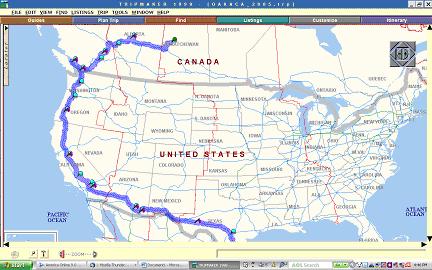
We had planned to stay at a campsite in Sutherlin, Oregon, but found a spot in a rest area and slept among the truckers and other RV’s. Sometime before first light we got moving again and stopped for fuel and a breakfast snack and carried on southward on I5 into California. We had planned to fuel up at a Flying J truck stop just south of Sacramento and overnight it there, but it was not close to dark and there was a long line at the RV pumps so we bought some baked goods and carried on. By now we were on Hwy 99. (note to self - in future stay on I5 and cut across further south) and doing okay, but it started getting dark and that was still okay and we were plugging along and planning to make to the next rest area and sleep and then the rain started and I took the next exit. There was a large parking lot with a few semis in it behind a Mexican restaurant. I parked, went in and asked if was okay to stay overnight. They said “yes” so we had dinner and went to sleep. The parking lot was right next to an active railway line. That was okay because the dinner and breakfast were great and the price was right. The noise might have bothered us more if we had been paying to park in the RV park on the other side of the same tracks.
Well, up early and over Techahapi Pass. Starting to get better at shifting the transmission just before the turbo pyrometer alarm goes off, but still less than perfect. We then traveled through Mojave and down to Victorville, through Apple Valley and Lucerne Valley up the backside of the mountain to Big Bear Lake. ..................................................................................................................................... Until the sign:
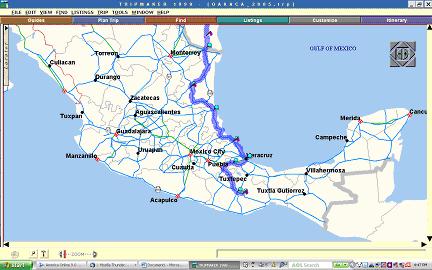
INTO MEXICO
The next morning we drove to the border, but got to the international bridge crossing by seven – too early to meet our contact so I decided to drive back to another border crossing and try and buy some pesos and Mexican vehicle insurance. Nobody takes Canadian dollars at money changers near the border or banks or anywhere at or south of the border. If you know somebody who says they do they must have been at an all inclusive resort or tourist area that caters to Canadians. We found the Sanborn’s office which opened at 8:30. Phoned our long suffering contact and suggested we meet at nine. We got there just behind three motor homes from Quebec, each with toads (RV speak for cars towed behind motor homes).
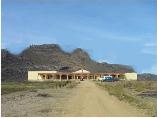
CLICK ANY PHOTO (ALMOST ANY) FOR A LARGER VIEW!
My Travel Log
Nothing in this site is copyrighted -- I'd be honored if you'd reuse anything you find here for your website
Click any photo for a larger view
69. From Canada to Mexico ... and Back











